Facts About Dangerous Animals – World’s deadliest reptiles
We take a look at the most dangerous reptiles on Earth!
From snakes to crocodiles, the deadliest reptiles on our planet have a variety of ways to kill, stun or disable a foe. Some, like the king cobra, possess a fatal amount of venom that they inject into their prey, while others like the saltwater crocodile use their strength to overpower enemies.
Across all corners of the globe lurks a reptile with the potential to cause harm. While some are unjustly feared despite their timid nature, others are not nearly feared enough. Attacks on humans in most cases are rare due to the knowledge of how dangerous these creatures can be.
However, they are not unheard of, and when one of these animals is cornered or threatened its aggressive nature can quickly become apparent.
Read on and take a look at five of the planet’s most lethal carnivorous reptiles, as we pit them head-to-head to find out which is the most deadly.
King cobra
Time to death: 15 minutes
The largest venomous snake in the world, it strikes fear into the heart of its prey.
Fortunately for us, the king cobra is generally shy and will slink away from humans. However, when defending itself or its eggs it is one of the most deadly reptiles known to man. When facing an attacker the cobra is able to raise 1.8 metres off the ground and move forward to attack.
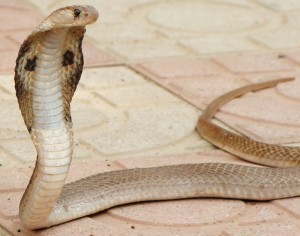 They live in undergrowth present in rainforests and humid jungles. One of their terrifying characteristics is the ability to slide up trees, surveying the area and finding prey from above. They primarily eat other snakes and smaller reptiles, preferably non-venomous snakes. To find prey, it can “smell” nearby chemicals with its forked tongue.
They live in undergrowth present in rainforests and humid jungles. One of their terrifying characteristics is the ability to slide up trees, surveying the area and finding prey from above. They primarily eat other snakes and smaller reptiles, preferably non-venomous snakes. To find prey, it can “smell” nearby chemicals with its forked tongue.
To kill, the king cobra strikes and pierces its prey with its fangs, injecting a lethal amount of venom. A single bite from a king cobra will typically contain 6-7ml of neurotoxin, which is enough to kill up to 20 people. It then devours the creature whole. They are the only snakes that make nests for their eggs, and a female king cobra will lay anywhere from between 20 and 40 eggs at any one time. King cobras are generally found in southeast Asia, with the largest living in Malaysia.
Gila monster
Time to death: 60 minutes
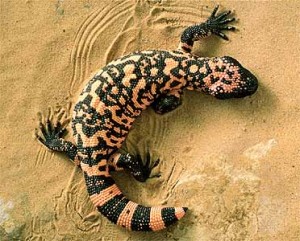 The only venomous lizard which lives in the United States is shy but can be very deadly!
The only venomous lizard which lives in the United States is shy but can be very deadly!
Found across several states in America, including Nevada and California, the Gila monster is known for being timid but potentially very deadly. Its main source of attack is its venom. The teeth of a Gila monster have grooves which channel the venom into the wounds of its prey. They are average-sized lizards with powerful Jaws and short legs adapted for digging.
Identifiable by their characteristic black bodies interspersed with orange, pink and yellow, Gilas are lethargic creatures that spend about 95 per cent of their lives underground in burrows. They eat mainly bird or reptile eggs and on occasion small birds, lizards and mammals. They are commonly thought to be very deadly and dangerous reptiles. However, their venom is primarily used for self-defence. They tend to bite their prey by surprise and come back when the venom has taken effect. Unless threatened, Gila monsters will only attack when seeking a meal.
Saltwater crocodile
Time to death: 1 minute
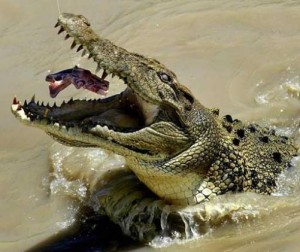 The largest living crocodilian on Earth eats anything, even humans!
The largest living crocodilian on Earth eats anything, even humans!
When tackling large prey or attackers, the saltwater crocodile will typically overpower, drown and then dismember them. The crocodile can hold its prey underwater as it can separate its mouth from its throat, allowing it to open its massive jaw when fully submerged. To finish off its prey it will either drag it to land or hold it above water and swallow it vertically.
They are very intelligent creatures, lurking beneath the surface of the water until potential prey arrives for a drink. Using their powerful tail, they then suddenly leap out of the water and drag their prey back underwater. In the last 25 years they have been responsible for the death of about a dozen people.
They mostly eat small fish and land vertebrates but they are not picky eaters. Any mammal in its vicinity is good food as far as a saltwater crocodile is concerned. They have even been known to attack boats, mistaking them for enemies. Their jaws have a biting force of up to 2,300kg per square inch, the most powerful bite on the planet. On land they use their strong legs to move, while underwater they use their giant tail for propulsion.
They are generally found in brackish (slightly salty) waters such as rivers, swamps and estuaries. They are also occasionally seen in the open sea as they can swim up to 1,000km (620 miles), but they are most commonly found in northern Australia, southeast Asia and eastern India.
Komodo dragon
Time to death: 3 days
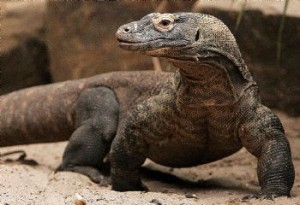 The world’s heaviest living lizard is also one of the most dangerous reptiles!
The world’s heaviest living lizard is also one of the most dangerous reptiles!
These huge lizards like to live an isolated existence except during mating season, when males will patrol and defend a territory up to 1.9km (i.2mi) long per day. They are found only on a small group of Indonesian islands in the Flores and Bali seas.
Komodo dragons are cannibalistic, but will also eat large prey such as pigs and deer of a similar size to themselves. Like saltwater crocodiles they are not fussy eaters, and will eat almost anything they can overpower, including other dragons. They are very quick eaters: a 45kg dragon was observed to eat a pig almost its own weight in 20 minutes, equivalent to a human eating 320 quarter-pound hamburgers in the same time.
It was only discovered in 2009 that Komodo dragons possess a deadly amount of venom, which they use to kill their prey. When hunting, a dragon will keep a vice-like grip on its prey with its mouth. Venom then seeps into large wounds on the prey made by the teeth. The prey goes into shock and bleeds to death. Although they have a similar-sized skull to that of a saltwater crocodile, the bite of a dragon is only one-sixth as strong.
Green anaconda
Time to death: 2 minutes
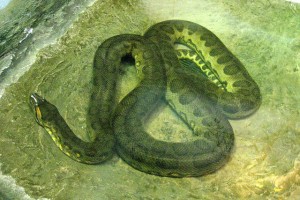 The biggest snake in the world is at its most dangerous when underwater!
The biggest snake in the world is at its most dangerous when underwater!
Although its cousin, the reticulated python, might be longer than the green anaconda, it pales in girth comparison, as the anaconda is not only long but also incredibly thick. They are one of the few reptiles where the females outsize the males. They tend to live in swampy marshes and streams in the tropical rainforests of the Amazon and Orinoco basins. On land they are slow and clunky but in water they are reptiles to be reckoned with. Like the saltwater crocodile, they wait submerged in water for prey to approach, using their eyes and nostrils on the top of their head to see around and breathe.
Like the king cobra the green anaconda swallows its prey whole, digesting it as it moves down its body. Its teeth are angled backwards, so that once it has bitten its prey, any attempts to escape will only impale the animal further. They feed on animals as large as jaguars and also pigs and deer. Their main method of attack is constriction; they are known as non venomous constrictors. They wrap their bodies around prey and squeeze until asphyxiation occurs. Again, they can go months without eating after a large meal.
